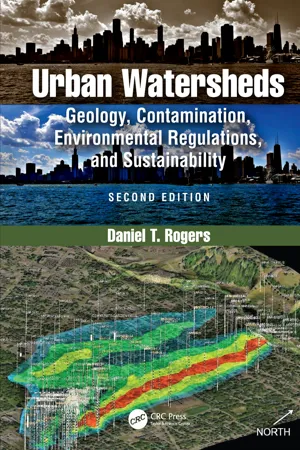
Urban Watersheds
Geology, Contamination, Environmental Regulations, and Sustainability, Second Edition
- 584 pages
- English
- ePUB (mobile friendly)
- Available on iOS & Android
Urban Watersheds
Geology, Contamination, Environmental Regulations, and Sustainability, Second Edition
About This Book
Understanding that the natural world beneath our feet is the point at which civilization meets the natural world is critical to the success of restoration and prevention efforts to reduce contaminant impacts and improve the global environment because of one simple fact – contaminants do not respect country borders. Contaminants often begin their destructive journey immediately after being released and can affect the entire planet if the release is in just the right amount, at just the right location, and at just the right time.
Taking an interdisciplinary approach, Urban Watersheds, Geology, Contamination, Environmental Regulations, and Sustainability, Second Edition presents more than 30 years of research and professional practice on urban watersheds from the fields of environmental geology, geochemistry, risk analysis, hydrology, and urban planning. The geological characteristics of urbanized watersheds along with the physical and chemical properties of their common contaminants are integrated to assess risk factors for soil, groundwater, and air. This new edition continues to examine the urban environment and the geology beneath urban areas, evaluates the contamination that affects watersheds in urban regions, and addresses redevelopment strategies.
Features of the Second Edition:
-
- Examines contaminants and the successes of environmental regulation worldwide and highlights the areas that need improvement
-
- Describes several advances in investigation techniques in urban regions that now provide a huge leap forward in data collection, resolution, and accuracy
-
- Explains the importance of understanding the geological and hydrogeologic environments of urban and developed regions
-
- Provides new and enhanced methods presented as a sustainability model for assessing risks to human health and the environment from negative human-induced contaminant impacts
-
- Includes a new chapter that surveys how environmental regulations have been successful or have failed at protecting the air, water, and land in urban areas
Suitable for use as a textbook and as a professional practice reference, the book includes case studies on successful and unsuccessful approaches to contaminant remediation as well as practical methods for environmental risk assessment. PowerPoint® presentations of selected portions of the book are available with qualifying course adoption.
Daniel T. Rogers is currently the Director of Environmental Affairs at Amsted Industries Inc. in Chicago, Illinois. His writings address environmental geology, hydrogeology, geologic vulnerability and mapping, contaminant fate and transport, urban geology, environmental site investigations, contaminant risk, brownfield redevelopment, and sustainability. He has taught geology and environmental chemistry at Eastern Michigan University and the University of Michigan.
Frequently asked questions
1 | Urban WatershedsGeology, Contamination, Environmental Regulations, and Sustainability |
1.1 INTRODUCTION
1.2 MAJOR THEMES OF THIS BOOK
1.2.1 THEME 1: THE ROLE OF GEOLOGY IN THE URBAN ENVIRONMENT
Table of contents
- Cover
- Half Title
- Title Page
- Copyright Page
- Dedication
- Table of Contents
- Preface
- Acknowledgments
- Author
- Chapter 1 Urban Watersheds: Geology, Contamination, Environmental Regulations, and Sustainability
- SECTION I Geology and Hydrogeology of Urban Watersheds
- SECTION II Contaminants and Their Behavior in Nature
- SECTION III Environmental Regulations and Sustainability
- Glossary
- List of Important Websites
- Index